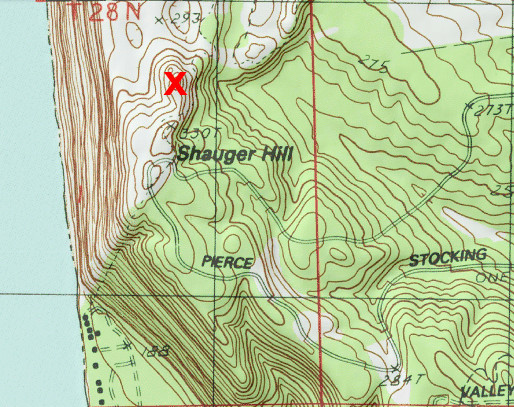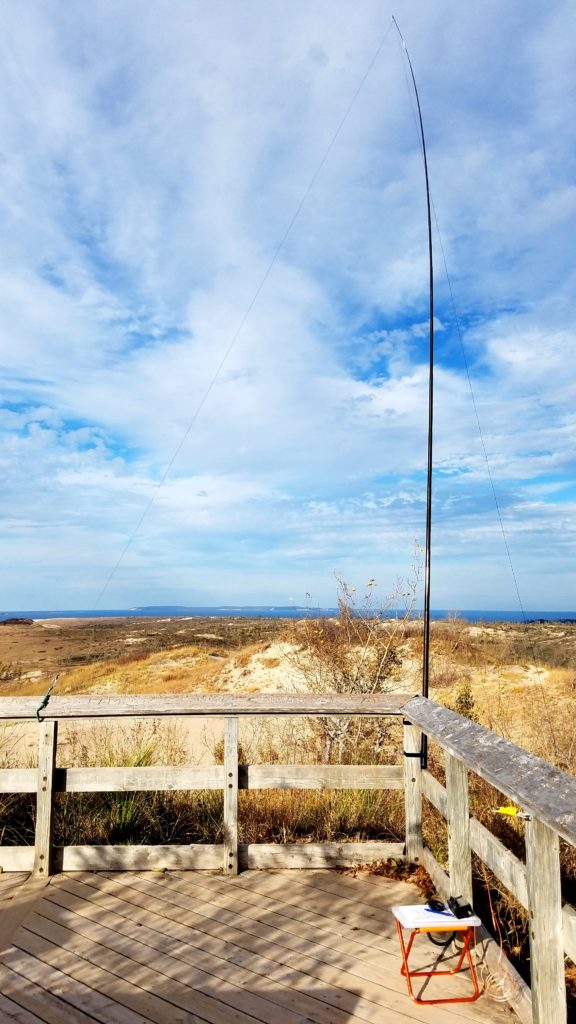Not so long ago I was lucky to spend a great weekend with my friends camping in Michigan. We explored the Sleeping Bear Dunes National Lakeshore and surrounding areas in the Lower Peninsula. Of course, being a field radio enthusiast and Parks on the Air fanatic, I couldn’t miss this opportunity to activate a new park, and operate from a new State. In addition to that, this was a perfect chance for the first real field test of my ultra-portable HF radio station that I was working on in the past few months.
According to my preparation process, I spent some time studying the terrain and topography around the places that we were planning to visit. Since I was traveling with friends who are not interested in amateur radio, this was not the main goal of the trip, and I did not want to make anyone step too far away from what they wanted to do. Thus, I looked for an operating position where I could be dropped off and later picked up without significant alteration of the schedule or route.
Thankfully, I soon discovered that one of the highest points within the park limits is conveniently located not too far from one of the stops on the Pierce Stocking Scenic Drive that we planned to drive through anyway. Thus, the time and place were set!


It was a short 0.2-mile hike from the parking lot – so I can’t say that this was the reason for me to appreciate how lightweight my portable station was. However, I was pleased by how compact it turned out to be, and how easily it fit into my backpack along with all the rest of stuff that I needed for the day. I appreciated how travel-friendly my station was even before coming to Michigan – since I didn’t drive to Chicago, but rather took a bus, it was a good test for my future air travels with this setup.

Even though the parking lot was full at this stop of the Scenic Drive, and the trails were relatively populated all across the park – my operating location was somewhat remote, and not too many people made it there. Once on the place, I was rewarded by beautiful views of the Lake Michigan in the west, and dunes, forest and Glen Lake in the east. This great horizon also meant that I’m on the top, and got myself a few extra points for better propagation!

Setting up took only a few minutes. The SOTAbeams Tactical Mini mast went up in a blink of an eye, hoisting up my PackTenna random wire in a test-proven inverted V configuration. Unfold a very lightweight camping chair that I picked up from Amazon for this specific adventure, hook up my KX2 – and I’m on the air!
There was a challenge for my planned activation that I got mentally ready for in advance: a major contest (Worked All Germany) packed the 20 meters band almost wall to wall with high-power stations from across the Atlantic, and many US amateurs who chased them. In addition to that, the Scout Jamboree on the Air was active at the same time, together with the New York QSO party that occupied pretty much the whole 40-meter band. To be objective, though, I have to compliment a very smart move of the organizers of the German contest: their rules identified a contest-free portion on each band allowed in the contest, with the spirit of good neighborhood with the radio amateurs who do not share the excitement of contesting. I think other contests should follow this example as well.
I already had some experience activating parks during various QSO parties. I once resorted to chasing contacts from TX and AL QSO parties participants while struggling with storm-related noise on the bands – however, I used my full-power 100 W station for that activation. I also had reasonable success with the CA QSO party while testing my low-power station – however, I had my antenna deployed at 85 feet above ground on an observation tower of the park. This time, I had low expectations regarding my ability to chase some DX, thus I tried to park somewhere to call CQ. However, I was chased off by QRM several times, and decided that further efforts will be just a waste of time.

While browsing the bands, I was able to make a few contacts with the New York stations working the QSO party on 40 meters. I also hunted two park activators and scored park-to-park contacts with WØYES in K-4238, and with Jason W3AAX activating K-0334. I even wandered out to the 15 meter band, where I happened to hear the W1AW/6 station working Jamboree on the Air. I stopped there for 10-15 minutes to talk with a few girl scouts and cub scouts from California – they were pretty excited to know that I am speaking with them from the beach, and one of the girls proudly announced that she just returned back from visiting her friend in Michigan, not too far from where I was.
However, I decided that the experiment will not be complete without even trying to chase some DX. Thus, I started sweeping the 20 meters band from left to right, spending some time at each station that was strong enough for me to hear (and, to my delight, there were dozens!), but did not have a huge pileup. To my astonishment, they actually heard me! My signal, coming from a 10-watt transmitted into 50 ft of wire 20 ft up in the air, was making it across the ocean!
It took me anywhere from 1 to 15 minutes of persistent calling to break through the pileups and log 8 contacts with German (and one Italian) stations located at 6450-6900 miles away from me. With some stations I never made it. Sometimes it was frustrating – but every time I did score a QSO, it felt like an accomplishment! Then I though to myself that this was probably one of the true spirits of amateur radio.

I spent two hours operating at the top of the dune, and walked away with not too many contacts in the log. Indeed, it was one of the most challenging activations – but also one of the most inspirational! I worked from one of the most scenic places (that so far could only compete with my activation of the Black Hills National Forest earlier in June). I managed to make several transatlantic contacts with just 10 watts. I also got to be an ambassador of our hobby, explaining to people around what it was that I was doing (I didn’t use headphones for purpose – foreign stations or my conversation with Scouts in the KX2’s speaker raised the most questions, including those from the kids!). I am definitely looking forward for more adventures with this station coming soon!